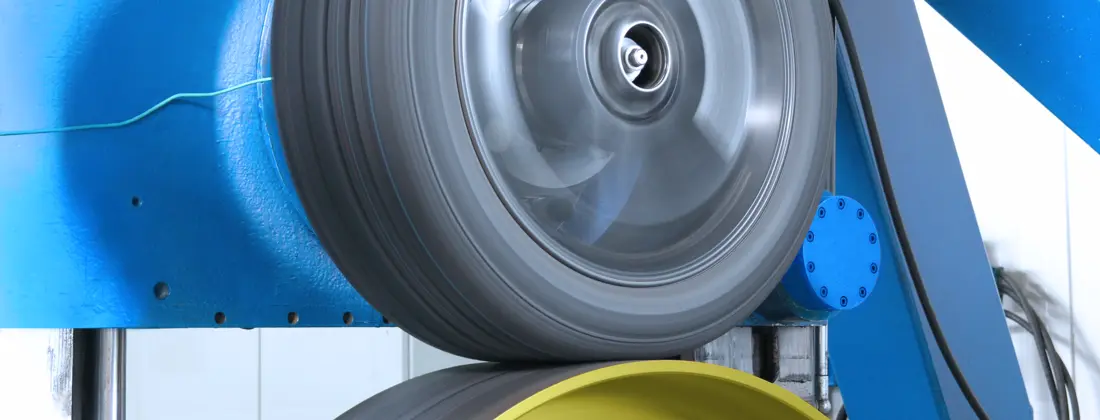GB T4513 Motorcycle Tyre Speed Performance Testing
The GB/T 4513 standard specifies the method for testing the speed performance of motorcycle tyres. This is a critical aspect of tyre safety and performance, especially in high-speed environments such as motor racing circuits or when operating motorcycles at high speeds on public roads.
The test aims to determine how well a motorcycle tyre can maintain its grip and stability under conditions that simulate real-world driving scenarios. The standard requires the tyres to be tested on a rolling road, which simulates the forces acting upon the tyre during dynamic operation. This ensures that the tyre's performance is evaluated in a controlled environment where factors such as temperature, humidity, and tyre pressure can be precisely managed.
The testing process involves mounting the motorcycle tyre onto a specially designed test wheel and placing it on a rolling road. The tyre is then subjected to a series of speed increments, starting from low speeds up to the maximum specified in the standard. At each increment, the tyre's performance is evaluated based on its ability to maintain traction, stability, and handling characteristics.
The test procedure also includes measuring the temperature rise within the tyre during the high-speed runs. This helps assess the heat generation capabilities of the tyre, which is crucial for ensuring that the tyre does not overheat and lose grip under extreme conditions. The standard specifies detailed acceptance criteria that define the maximum allowable temperature increases to ensure that the tyre remains safe and performs optimally.
For quality managers and R&D engineers involved in motorcycle tyre development, this test is essential for validating new designs and materials before they are introduced into production. It allows them to identify any shortcomings in the tyre's performance under high-speed conditions and make necessary adjustments to improve safety and handling.
The GB/T 4513 standard is widely recognized and used across the automotive industry, particularly by manufacturers of motorcycles and related accessories. Compliance with this standard is crucial for ensuring that motorcycle tyres meet stringent quality and safety requirements, thereby protecting both riders and pedestrians on the road.
| Applied Standards |
|---|
| GB/T 4513:2019 - Motorcycle Tyre Speed Performance Test Method |
Why It Matters
The GB T4513 motorcycle tyre speed performance test is essential for ensuring the safety and reliability of motorcycles. High-speed driving conditions, such as those encountered in racing or on busy roads, can put significant stress on tyres. A tyre that fails to perform well under these conditions could lead to accidents, endangering both riders and others on the road.
The standard not only tests the tyre's ability to maintain traction but also evaluates its durability and resistance to heat buildup. By subjecting the tyre to controlled high-speed environments, engineers can identify any weaknesses in the design or materials used. This information is invaluable for improving tyre performance and safety.
From a regulatory perspective, compliance with GB/T 4513 ensures that motorcycle tyres meet the highest standards of quality and reliability. This is particularly important given the growing popularity of motorcycles and the increasing demand for safer vehicles. Manufacturers who comply with this standard can gain a competitive edge by demonstrating their commitment to producing high-quality products.
For procurement professionals, selecting suppliers who adhere to GB/T 4513 ensures that they are working with companies that prioritize safety and performance in their tyre manufacturing processes. This helps maintain the integrity of the supply chain and ensures that only the best products reach the market.
Applied Standards
Quality and Reliability Assurance
To ensure the highest level of quality and reliability in our GB T4513 motorcycle tyre speed performance testing, we employ a rigorous process that includes:
- Preparation of Specimens: Tyres are carefully prepared according to the standard specifications to ensure consistency in test results.
- Calibration and Maintenance of Equipment: All testing equipment is regularly calibrated and maintained to guarantee accurate measurements.
- Consistent Test Conditions: Temperature, humidity, and other environmental factors are controlled to simulate real-world conditions as closely as possible.
- Data Analysis: Comprehensive data analysis is performed using advanced software tools to ensure precise evaluation of tyre performance metrics.
We also provide detailed reports that include all relevant test data and recommendations for any necessary adjustments or improvements. This ensures complete transparency and traceability in the testing process, allowing our clients to make informed decisions based on accurate and reliable results.





